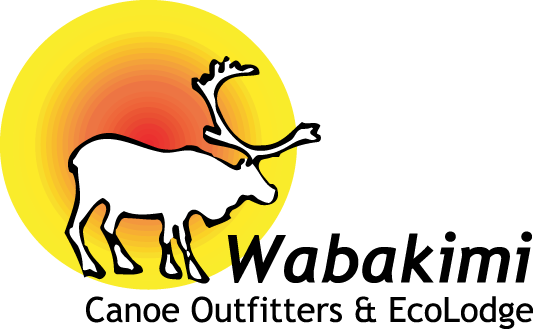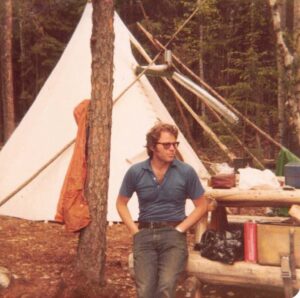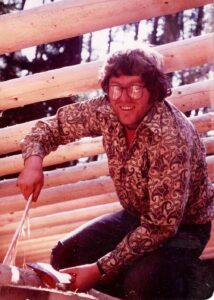Wabakimi Stories
A Small Boy’s Real Log Cabin
By Bruce Hyer (written in 1992, to describe the creation of the original small park core in 1983)
One archetype of this century is the white American urban male, with career and house, who throws it all over to move to the wilderness of Alaska or Canada. I don’t know how well I fit the mold, but it may be of interest to some to hear one perspective of how the Boreal forests of northern Ontario match Yankee urban fantasies of the Canadian wilds.
From the time I was a very small boy in New England, I had always wanted to grow up to build, and live in, a real log cabin in “The North.” Most of my allowance when I was little went for flashlight batteries to read under the covers after curfew. I exhausted all the librarians and library shelves within bicycle distance looking for books with titles like We Went to the Woods, Cache Lake Country, Wilderness Survival, Building a Wilderness Log Cabin, and Feasting on Wild Edibles. When folks askedme at age five what I wanted to be “when you grow up”, I answered “I want to move to Canada, build a log cabin and live in it in the wilderness, and be a trapper, wilderness guide, and bush pilot”. Then they smiled and patted me on the head.
My father loved canoes and canoeing. I paddled whitewater rivers throughout New England with him, but he associated camping with living in foxholes in the South Pacific while being shot at in W.W. II, so I had to join Boy Scouts to escape on weekends to go backpacking and tenting. It was fun, but I knew that it wasn’t the “real” wilderness that I sought.
In 1965, while in university, I was walking past a classroom when my ears caught the words “height of land,” “portage,” and “maybe runnable.” I backed up, eavesdropped, and inveigled my way in. The professor, a former consul to Ottawa, was planning a northern Quebec excursion with student and Canadian friends. Alas, there were no openings, but I made hopeful noises, and left my address and phone numbers. Fate took over. One student went to Vietnam, and I went to Clova, P.Q.
The train from Ottawa changed at La Tuque, and became a time machine, dropping us at 2:00 a.m. at a siding along the CN tracks, somewhere in the eighteenth century. Two weeks and 200 miles later, my life was forever altered. Everyone reveled in the fresh air, the fishing, the white water, the camaraderie. For me, it was total, albeit pleasant, shock. It was as if I had been there before. Nothing was strange. No adaptation was required. Was it genetic imprinting? Was it reincarnation? I was reborn. I was home.
For the next decade, I was in my glory. Each summer, I could look forward to a new adventure, ever more north, ever more remote and beautiful. I had the best of both worlds. I could pursue my chosen career of environmental management, enjoy urban toys, symphonies, family and friends. Every summer I could ride those magical time machines: the rails, the floatplane, and the canoe. Labrador. Yukon. Northwest Territories. I could do this forever. I became smug with the knowledge that all that wilderness would be there: summertime tonic and wintertime fond memory. I would help save civilization from pollution. Wilderness would remain. Maybe I would retire to that log cabin. There was no hurry.
My first repeated trip. Back to central Quebec, perhaps the finest wilderness canoeing anywhere. Up the Megiscane, up the Riviere St-Cyr, up to Barry Lake, where the river flows both north and south, in a portage-free divide. Barry Lake, where at the centuries-old natural campsite on the point I had previously found both an arrowhead and a fur-trade-era coin in the sand. We paddled all day, upstream, heads bent against the north wind and rain. I wouldn’t hear of stopping; I had a date with the voyageurs at Barry Lake. The rain slackened. One more riffle to wade, one last point to round. Again Boreal Quebec offered a shock. The Jet Ranger helicopter lifted off, rocketing toward us just below the ceiling of grey scudding clouds.
“Hey, Bruce. I thought you said this river was wild.” No answer. I paddled numbly to the old campsite, now bulldozed flat to make room for helicopters, tents for dozens of men, barrels of Jet B, and mounds of trash. We were a hit. We all, especially the women, had lots of attention from the Quebecois pilots, engineers, and labourers. Ice cream, steaks, and helicopter rides bought quick friends among the rest, while I hovered, chopper-like, somewhere between shock, depression, and rage. The head engineer showed me maps of how the Eastmain, the LaGrande, the Mistassini, and other old/new friends would be buried monuments to progress, Robert Bourassa, and Quebecois autonomy. In an afternoon my world changed. I had long known that civilization was progressing, but my sense of that progression had been arithmetic. The good people of the Sierra Club were supposed to halt, or at least slow, that civilized advance; I had preferred to believe. In an afternoon, my smugness evaporated like the mist over Barry Lake. The maps told of a 1000 mile leap by roads, dams, and the biggest high-tension towers in the world. I returned to a USA where nobody knew, nobody understood, and nobody cared.
My comfortable assumptions were in tatters. My downtown office chair was no longer padded with cosy memories of my inviolable wilderness. I would NOT wait for the gold watch and the log cabin. I would experience wilderness now, and help show it to others who could help save it. After two years, and a lot of homework, I selected a spot just off the good old CN line, west of Armstrong, Ontario. This time there would be protection. The Ministry of Natural Resources district forester assured me that “There will never be any logging around there; the wood’s too small, and the sites are too fragile. There are too many rivers and lakes, and it’s too far from the mill.” The district lands’ supervisor reaffirmed: “We know of no plans for any kind of development, probably for decades, if ever.” These were the guys who should know. I returned home, infected my wife with my zeal, quit my job, sold most possessions, hugged friends and family goodbye, and left to start a wilderness canoe outfitting business.
May 26, 1976. All our earthly possessions were unloaded from the old Suburban and piled on the CN platform in Armstrong. Six canoes, five tents, lots of log-building tools and books, and about 50 kg of rice were loaded onto the midnight train, filled with trappers, schoolteachers, missionaries, Indians, and tourists. We didn’t know a soul in northwestern Ontario, and were brimming with equal amounts of apprehension and excitement. A German tourist bought me a cold Molson’s in the dining car, and I reflected on my wisdom in moving to a province that had committed to good rail travel, returnable stubby beer bottles, and land use planning with voluminous rules (unlike Quebec, where anyone could put up a patates frites stand or dam wherever they chose).
Approval for a cabin took longer than I suspected, and I had to call a tipi home for over a year, while Harriet did substitute teaching in Thunder Bay to keep up the cash flow. It was frustrating that the bureaucracy moved so slowly, but I took solace in the thought that MNR staff were so slow and careful with their wilderness management. Indeed, one day an MNR “yellow bird” landed; an official measured the distance from my tipi to the lake and informed me that I was almost 10 feet short of the 100 foot requirement.
I wanted to see my environs, so I headed north to Hudson Bay with a fishing rod and a .22 rifle, to Fort Hope, Attawapiskat, Webequi, and Winisk, on a six-week solo trip that left me about as skinny and happy as I’ve ever been. I found that given enough hunger, one could eat entire walleyes…bones, skin, and all! That winter, I made friends with several Indian neighbours who taught me how to trap. One wonderful discovery was that among my other neighbours were several hundred secretive woodland caribou, as sure an indicator of “real” wilderness as there ever was.
Book in one hand, axe in the other, I tackled the cabin that was to become home for another year. Selecting each straight black spruce with care, I agonized about cutting them, and about the tracks that I made in the deep feather mosses. I selected a site a few hundred yards back in the forest, as I felt guilty about civilizing this wild lake. An Indian neighbour assured me, “Never before has any man lived at Shawanabis Lake.” Indian neighbours who had been open and friendly when I had lived in the tipi became distant and almost hostile as the obviously more permanent cabin rose on their ancestral lands.
The next summer, on my rare excursions to town, I began to hear rumours of a proposed logging road and cutting. The MNR said they knew nothing of such plans. I went directly to Thunder Bay, to talk to a mill woodlands division executive. “It’s none of your business. We hold the timber licence, and we’ll do what we want. Besides, you outfitters are all crooks and bandits. Your customers are all goddam Yankees, and the sooner you all go out of business, the better.” I left the steaming, odiferous pulp mill in a rage, which shimmered into a firm resolve. The Ogoki-Albany wilderness was too fragile and valuable to become “one week trees”, in their dizzying ride from Armstrong to Thunder Bay, where only the pollution remained while newsprint cellulose would live forever in a Chicago landfill.
Lobbying from a log cabin 25 miles from the nearest road is somewhat ineffective, so I headed for Thunder Bay, for “six months, or possibly a year.” School bus driver. College teacher. Log cabin instructor (well, I had built one…). Contract moose biologist, racing the wolves and ravens to be up to my elbows in ripe gut piles. My MNR supervisor got wind of my conflicts with his timber branch. “Bruce, you’ve got to remember that MNR bureaucrats are like elephants; they’re long lived, they’ve got long memories, and someday you’re going to need something from them. When that time comes, do you want to get stepped on?”
I went to see members of the Parks Branch, many of whom reminded me of furtive lemurs emerging from the shadows, with big eyes watching for predaceous foresters. Finally, one lowly parks planner arranged a clandestine meeting in a little-visited beer parlour. When I launched into my usual speech about the fragility, beauty, and recreational potential of the Ogoki area, he pulled out a map, onto which was drawn the Whitewater Lake Candidate Wilderness Area, or just “Whitewater.” We don’t want the company to find out about this yet, or it will be killed before it ever gets into the draft plan.” What plan? “SLUP.” What in heavens name is that, a new kind of slurpy frozen drink? “Strategic Land Use Plan for northwestern Ontario.” He need never have been so secretive. The plan, together with a memo from an MNR forester worried about the threat from his Parks Branch, had already gone to the company in question: “I advise you to quickly get a plan in place for roads and cutting, to preempt our pinko parks people. Kill it before it multiplies.”
The problem was that given the distance from the mill, the predominance of bedrock, and lack of road-building gravel, the area didn’t appear to be economic to harvest. Never fear, the feds would come to the rescue. A secret subsidy request went to DREE (Department of Regional Economic Expansion). A brown manila copy came to me. I showed it to a friend, a fly-in lodge owner who had always been, like most outfitters, somewhat nervous of my talk of parks. “It’s time to fish or cut bait, Don. Do you outfitters want a park that may cramp your style, or massive clear cuts and roads, which will surely put you out of business? If you support the park, I’ll do my best to get grandfather status for the local and traditional users.”
Don Plumridge organized an Armstrong Wilderness Outfitters’ Association, with a handsome caribou logo on the letterhead, on which he wrote powerful and articulate letters to bureaucrats and MPs. I commuted endlessly to Toronto, the source of all Ontario political and economic power, wondering all the while if I would ever get to live peacefully in that wilderness cabin…and if there would even be a wilderness around it. I had given up a rather lucrative environmental career in one city to take on an unpaid environmental career in one of the biggest and busiest cities in the world. I wasn’t getting anywhere very fast, and my life savings were rapidly being transferred to the current accounts of those two “Canada’s,” Air and Bell.
I showed slides to ministers. I showed slides to politicians. I showed slides to the Parks Council. I showed slides of bedrock, moss, caribou, and waterfalls to the FON and the Sierra Club. Eureka! Ron Reid and Rick Simms gathered kindred spirits Janet Grand and George Luste, and showed up at my Shawanabis Lake cabin for a two-week trip. There really was an undiscovered wilderness gem northwest of Armstrong! They gained the interest of the like of World Wildlife Fund’s Monte Hummel and the Algonquin Wildlands League’s Arlin Hackman. They connected me to Thunder Bay’s indomitable Bill Addison and Dave Bates, and the quietly effective naturalists Mike and Sue Bryan. The network was building, and into the mélange was thrown a new minister, Alan Pope. Where many ministers are led around by the nose by their deputies, Pope was different. He trampled bureaucrats mercilessly, and connected directly and privately not just with multinational companies but with trappers, outfitters, and parks advocates. He played his cards close to his chest, but when the smoke cleared in 1983, Ontario had dozens of new parks, including a couple of new wilderness areas. It was a quantum leap, but all the news wasn’t entirely good. Some site regions were represented inadequately or not at all.
Of particular disappointment was Ogoki-Albany/Whitewater, which was only 750 square miles compared to the over 2500 square miles recommended by the parks planners and the Parks Council. Alan Pope held a press conference in Thunder Bay, accompanied by a beautiful map of the new parks in northern Ontario. Graphic artists had skillfully drawn in all of the parks except for one. Now called Wabakimi (which ironically means “white waters” in Ojibwe), the new park northwest of Armstrong had shrunk to the smallest of three concentric circles, the outer two having been crudely obliterated with ordinary steno whiteout. Clearly, the battle between the Timber Branch and the Parks Branch had continued literally until the eleventh hour…and the Parks Branch had not won.
We gathered for a beery postmortem. Anger at the Wabakimi decision was swallowed in the pleasure of the other new parks, and in the relief that the alphabet soup of MNR land-use-planning acronyms was history.
Years later, parks supporters are beginning to recover from the old war wounds. There are new stirrings. World Wildlife Fund is leading the charge this time, with their Endangered Spaces program. New MNR planners are talking of the need to expand Wabakimi: virtually all the natural features that were the raison d’etre are outside the park, along with some of its caribou and their habitat.
For a few more years, perhaps a decade, plus or minus, some options for wildlife remain. A Wabakimi we can be proud of. Lake Superior Islands. Amazing Lake Nipigon, the only Great Lake that belongs entirely to Canada. Unrepresented natural site regions.
All we set aside soon for nature is all we will ever have. Can old parks warriors with new grey hairs rouse themselves to vigorous initiatives? Do we need to find and groom new young urban males, and females, to protect and help nourish their fantasies of wilderness waterways, loons and wolves calling under yellow moons…wild Boreal landscapes to show their children, and their children’s children? Maybe they’re under their covers tonight, devouring their wilderness tales in the yellow glow of their flashlights, and thinking of a real log cabin in “the North.”
(Postscript: this essay was written as a chapter in a beautiful coffee table book called “Islands of Hope”. There was hope, because we did not give up, and in 1995 and 1999 Wabakimi was expanded hugely, to a combined 5 million acres if the park itself and the attached Nature Reserves, Conservation Reserves, and Waterway Parks are combined)




